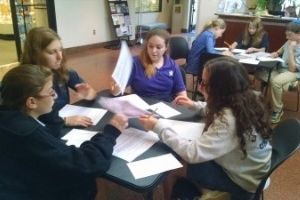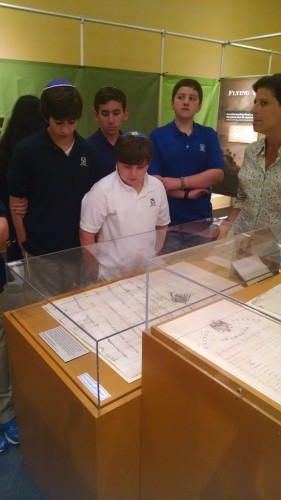Why Museums Need Guinea Pigs

A blog by Visitor Services Coordinator Abby Krolik. To read more posts from Abby, click here.
A few days ago we had our first opportunity to test out the educational programs we’d created for school groups visiting The A-Mazing Mendes Cohen exhibit. The 8th graders at Beth Tfiloh Dahan Community School were brave enough to sign up to be our guinea pigs!

Going into it, our education staff was unsure if we could manage more than ten students at a time inside the maze. Nightmareish images of children hiding in unseen corners and running roughshod over the interactives flooded our minds. Limiting the number of students allowed in the maze at one time would of course make planning field trips for large groups very awkward. We had to be creative about our use of time and space. The plan we came up with was based on the average group size of 40 students. We would split them in half—20 and 20—between Voices of Lombard Street and The A-Mazing Mendes Cohen. The 20 in Mendes Cohen would then be split again—10 and 10. The first group of ten would be led through the exhibit, while the second group did an archival activity in the Orientation Space. They would switch at 15 minutes, and then, at the half hour mark, switch with their classmates in Voices, and repeat.

We learned a lot by observing a school group go through the exhibit. The first thing we learned—much to our relief—is that it’s not as terrifying to take students through the maze as we’d imagined. We decided that it would not be impossible to even take up to 20 students at a time. The next thing we learned was that we really needed to give the students more time to go through the exhibit. It has so much to offer—from the fun of going through a maze, to the neat objects on display, and the hands-on interactives dispersed throughout the corridors and “rooms”—and no one was benefitting from having to rush through it.
The teacher also expressed her disappointment that we had put as much emphasis on the archival activity as on the exhibit itself. She felt that the archival activity could as easily be done in the classroom as at a museum, and she’d hoped for a more hands-on experience for her students. While I don’t think we should completely discount the appropriateness of utilizing our primary resources during a museum visit (many schools have limited access to these kinds of resources), we did take her critique to heart.
Afterwards, we went back to brainstorming: how could we supply just enough structure to make the school’s visit intellectually stimulating without making it seem like just another day in the classroom? How could we best get a group of students to not just walk through the maze, but to actually engage with its content? We had previously assumed that these two activities had to be separated—hence the archival activities. Now we needed to come up with a way of bringing the two together.
A major theme of the exhibit is the puzzle of Mendes Cohen’s complex identity. The exhibit seeks to demonstrate the different aspects of his character with his objects, letters, and actions. There are puzzle pieces scattered throughout the exhibit that list his attributes—e.g. “Family Man” and “Proud Jew.” Each of these puzzle pieces lifts up to reveal a question about how we know that Mendes was all of these things. At the end of the exhibit, we turn the question to the visitor: what are the attributes that make up you?

It was this central theme that led our Education Director, Ilene Dackman-Alon, to a breakthrough idea. For the next school group that visits us, we will ask the students to work in pairs to find each of the puzzle pieces in the exhibit, and to write down the answer to each one’s question. At the end of the exhibit, we will ask them to think of attributes that describe their own class. Each pair will contribute their attribute to a piece of the class puzzle that they will then get to take back to school with them!
We are very excited about this new plan! It can be daunting to have to go back to the drawing board after working so hard to come up with the first lesson plans, but actually knowing what it looks like to take a school group through the exhibit helped us shape what we hope will be an even better one.
